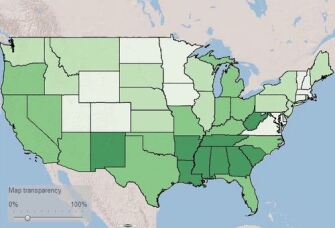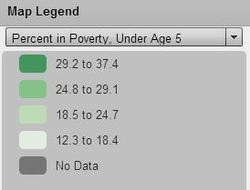Nationwide, child poverty in 2013 dipped for the first time this century, but nearly 30 percent of counties still have more children—particularly young children—living in poverty today than before the recession, according to the U.S. Census.
For those looking to dig into the detailed data (including an interactive mapping tool), the the Small Area Income and Poverty Estimates program has released information on how Americans 18 and younger have fared in about 3,140 counties and nearly 14,000 school districts nationwide. It shows concentrated poverty continues throughout the South and parts of the Southwest, with poverty for children under 5 reaching nearly 40 percent in some states, as the map below shows:

“County school-age child poverty rates are still above their pre-recession levels in metropolitan areas of California, Nevada, Arizona, Florida, Georgia, the Carolinas, as well as the coastal areas of the Northeast and Great Lakes states,” concluded Wesley Basel, researcher for the Census Bureau’s small area estimates branch, in a statement.

Among the findings:
• Fifteen percent of school districts had more than 30 percent of their students in poverty.
• In five states—Connecticut, New Hampshire, North Dakota, Rhode Island and Wyoming—80 percent of their counties had schoolage poverty rates below the national average of 20.8 percent.
• In Mississippi and New Mexico, by contrast, 80 percent of counties had higher poverty than the national average.
For the nation’s youngest children, poverty rates varied widely from state to state over time, with states like New Hampshire seeing sharp declines in poverty for the preschool set, while poverty rates in Mississippi remain stubbornly high.

Regionally concentrated poverty can make it considerably more difficult for school districts to turn around struggling schools, as greater need meets lower local and state financial support. The yawning gaps among states could make it even more difficult for Congress to eventually pass the next iteration of federal education law.
Charts Source: U.S. Census Bureau, Small Area Income and Poverty Estimates.


